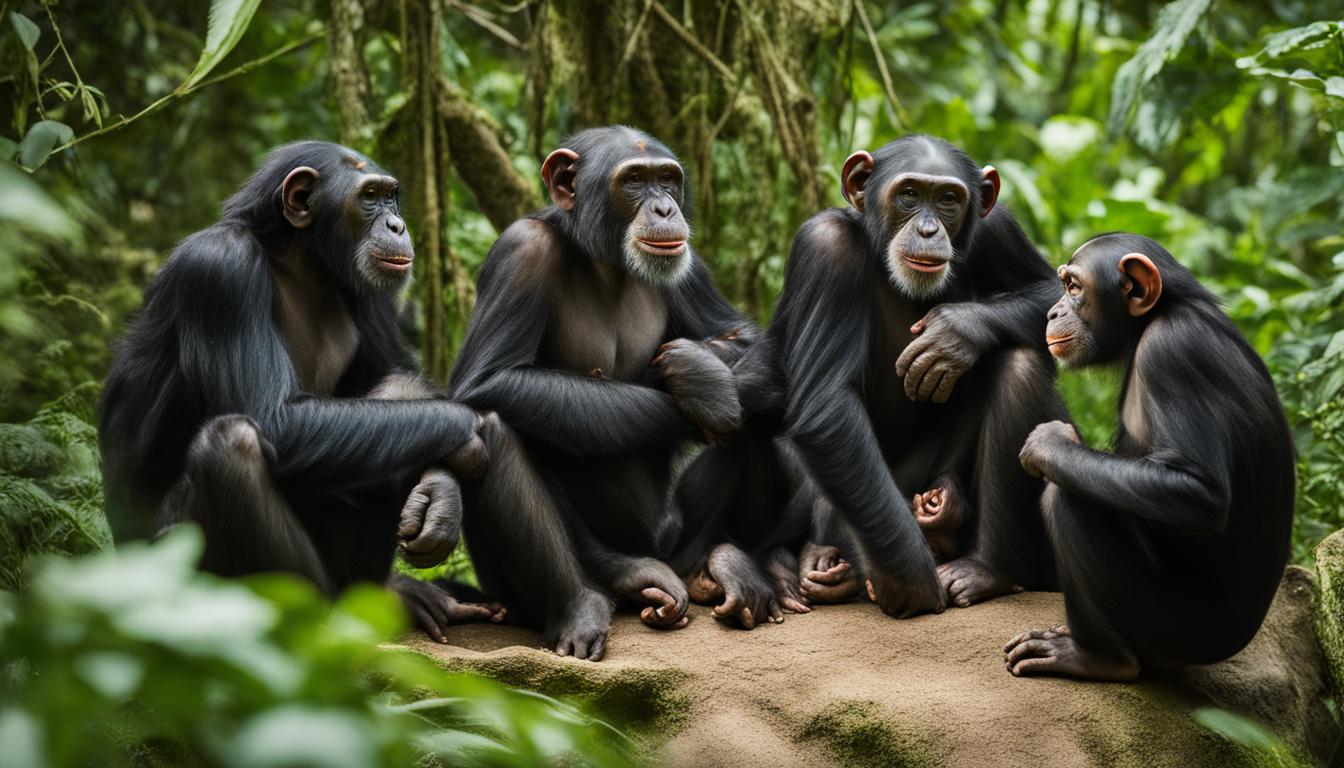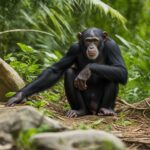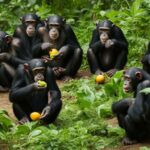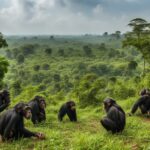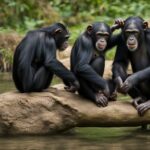Welcome to our exploration of chimpanzee family structure, social organization, and dynamics in the wild! Chimpanzees, our closest living relatives, have intricate social lives that revolve around their family groups. In this section, we will delve into the fascinating world of chimpanzee families and discover how they communicate, cooperate, and navigate their hierarchies. From kinship connections to cooperative breeding, we will uncover the secrets of chimpanzee group dynamics.
The Role of the Alpha Male in Chimpanzee Families
Chimpanzee families have a complex social structure characterized by dominance hierarchies and power struggles. At the top of this hierarchy is the alpha male, the highest-ranking male in the group. The alpha male’s role is essential in maintaining the social order within the chimpanzee family.
The alpha male gains his position through various means, including forming alliances and maintaining strong grooming relationships. These alliances and coalitions help him gain and maintain power within the group. However, there are often other males or rival coalitions that seek to overthrow the alpha and take his place, leading to intense power struggles within chimpanzee families.
Dominance relationships among chimpanzees are influenced by these alliances, and males form coalitions to defend their territory from other groups. These power dynamics and alliances shape the social structure of chimpanzee families and play a significant role in their overall behavior and communication.
The Importance of Leadership and Alliances
Leadership and alliances among chimpanzees are crucial for their survival and success as a social group. The alpha male’s leadership ensures stability and cooperation within the family, while alliances strengthen their position and provide support during conflicts or challenges. By understanding the role of the alpha male and the dynamics of alliances, researchers gain valuable insights into the social organization of chimpanzees and their evolutionary history.
| Key Points | Alpha Male and Leadership in Chimpanzee Families |
|---|---|
| Dominance Hierarchy | The alpha male holds the highest-ranking position in the group, maintaining dominance over other males. |
| Alliances and Coalitions | Alpha males form alliances and maintain strong grooming relationships to gain and maintain power. |
| Power Struggles | Other males or rival coalitions may challenge the alpha male’s position, leading to intense power struggles within the family. |
| Role in Social Order | The alpha male plays a crucial role in maintaining stability and cooperation within the chimpanzee family. |
Understanding the role of the alpha male and the dynamics of alliances in chimpanzee families provides valuable insights into the complexities of their social structure. These findings contribute to our understanding of both chimpanzee behavior and the evolutionary origins of leadership and power dynamics in humans.
The Alpha Female and Female Hierarchy in Chimpanzee Groups
Within chimpanzee groups, a hierarchical structure is also observed among females, with the highest-ranking female known as the alpha female. Unlike males, alpha females do not establish their position through aggression but rather through the use of force when displeased with lower-ranking females. This dominance relationship among females plays a crucial role in the overall dynamics of the group.
Higher-ranking females within the chimpanzee hierarchy often experience greater reproductive success and gain better access to food sources. The offspring of these higher-ranking females also have a higher likelihood of achieving a higher status themselves, perpetuating the hierarchy across generations. This highlights the significance of dominance relationships among females in shaping the social structure of chimpanzee families.
The alpha female, as the highest-ranking female, serves as a key figure in maintaining the social order within the chimpanzee group. Her role in decision-making, conflict resolution, and mediation contributes to the overall stability and functioning of the group. Understanding the dynamics of female hierarchy in chimpanzee families is essential for comprehending the complex social organization of these remarkable animals.
Additional Observations:
- Female chimpanzees form close bonds with related females and older siblings within the group.
- Alpha females may use their status to exert control and influence over lower-ranking females.
- Higher-ranking females tend to have more reproductive success and better access to resources.
| Rank | Behavioral Traits |
|---|---|
| Alpha Female | Dominant over other females, mediates conflicts, and makes decisions for the group. |
| Lower-ranking Females | Submit to the alpha female’s authority, may engage in conflicts with each other to establish their rank. |
Understanding the social dynamics of female chimpanzees provides valuable insights into our understanding of their behaviors, as well as our own evolutionary history. The complexity of their hierarchical structure and the role of the alpha female showcase the remarkable adaptations and social complexities of chimpanzee families.
Chimpanzee Culture and Communication
Chimpanzees, like humans, have their own unique culture and engage in social learning. They possess the remarkable ability to acquire new behaviors and knowledge from their peers and pass them down through generations. This form of cultural transmission is a key aspect of their society and plays a crucial role in their daily lives. From tool use to foraging techniques, chimpanzees exhibit an impressive range of cultural behaviors that vary between different groups.
One fascinating aspect of chimpanzee culture is their use of tools. They have been observed using sticks to extract termites from mounds and stones to crack open nuts. This tool use is not instinctive but instead learned and refined over time. Different chimpanzee communities may have their unique tool-use techniques, demonstrating the influence of cultural traditions within these groups.
Communication is another vital aspect of chimpanzee culture. They have a rich repertoire of vocal expressions that they use to convey various emotions and messages. From warning calls to communicate the presence of predators to excited vocalizations during social interactions, chimpanzees utilize their vocal abilities to maintain social cohesion and navigate their complex social dynamics. Additionally, tactile rituals such as grooming and embracing are common forms of communication and play essential roles in bonding and social bonding within chimpanzee families and communities.
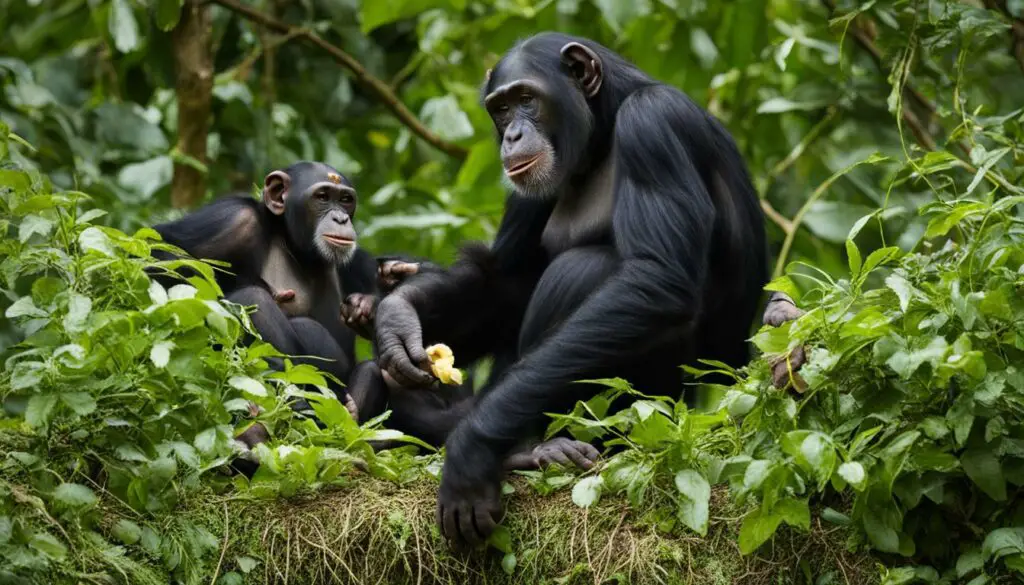
Social Learning in Chimpanzees
A significant factor contributing to Chimpanzee culture is social learning. Through observation and imitation, young chimpanzees acquire various skills and behaviors from their more experienced group members. This process of social learning allows knowledge and traditions to be passed down through generations, leading to the development of distinct cultural practices within different chimpanzee communities.
“The ability of chimpanzees to learn from one another and pass down knowledge through generations showcases their incredible cognitive abilities and highlights the importance of cultural transmission in their society.”
Researchers have observed that social learning is not limited to tool use and foraging techniques. It also extends to other behaviors such as courtship rituals, territorial displays, and social interactions. By observing and imitating their peers, young chimpanzees acquire the essential skills and knowledge needed to navigate the intricacies of their social world.
The study of chimpanzee culture and social learning provides valuable insights into the origins and development of cultural traditions in our own human species. It offers a window into our shared evolutionary history and highlights the importance of culture in shaping our societies. By understanding and preserving chimpanzee culture, we gain a deeper appreciation for the complexity and diversity of the natural world.
Chimpanzee Communities and Cooperative Behaviors
Chimpanzees, as highly social animals, exhibit remarkable cooperative behaviors within their communities. From foraging for food to defending their territories, these behaviors play a significant role in the social dynamics of chimpanzee groups. Understanding the cooperative nature of these primates provides valuable insights into their evolutionary history and sheds light on our own human behavior.
One of the notable cooperative behaviors among chimpanzees is foraging for food. They often engage in group activities such as searching for ripe fruits or “fishing” for termites. Sitting together for hours, they skillfully extract insects from termite mounds or share the bounty of a fruit tree. This cooperative foraging allows them to leverage their collective efforts and maximize their chances of finding food. It also reinforces the social bonds within the group while ensuring a steady food supply for all members.
Another fascinating cooperative behavior observed in chimpanzees is cooperative hunting. In certain circumstances, chimpanzees form hunting parties to pursue and capture small monkeys. By coordinating their efforts and strategizing their moves, they increase their chances of a successful hunt. This cooperative hunting behavior suggests a high level of communication and coordination among group members, emphasizing their ability to work together towards a common goal.
Chimpanzee communities also display territorial behavior, actively defending their territories against rival groups or trespassing males. They mark their boundaries through vocalizations, displays, and occasional physical confrontations. Furthermore, chimpanzees form alliances within their communities to strengthen their defense and preserve their territorial integrity. These alliances involve cooperation and mutual support, as individuals come together to protect their shared interests.
Table: Examples of Cooperative Behaviors in Chimpanzee Communities
| Cooperative Behavior | Description |
|---|---|
| Foraging for Food | Chimpanzees engage in collective food search, sharing resources and reinforcing social bonds. |
| Cooperative Hunting | Chimpanzees form hunting parties to pursue and capture small monkeys, increasing hunting success. |
| Territorial Defense | Chimpanzees actively defend their territories through vocalizations, displays, and alliances. |
The cooperative behaviors exhibited by chimpanzees highlight their social intelligence and the importance of collaboration within their communities. By working together, they enhance their survival and increase their chances of success in various endeavors, from foraging for food to defending their territory. These cooperative behaviors are fundamental to the social dynamics of chimpanzee groups and provide valuable insights into the evolution of sociality and cooperation in primates.
Cooperation is a remarkable aspect of chimpanzee communities. It not only highlights the intelligence and adaptability of these primates but also offers valuable lessons about teamwork and social dynamics in the animal kingdom. Through foraging, hunting, and territorial defense, chimpanzees demonstrate their ability to work together towards common goals, fostering social cohesion and ensuring the well-being of the entire group. Understanding these cooperative behaviors provides a deeper appreciation for the complexities of chimpanzee society and offers insights into the evolution of cooperation in our own species.
Threats to Chimpanzee Families and Conservation Efforts
Chimpanzees face numerous threats that jeopardize their populations and the stability of their families. The main challenges include habitat loss, poaching, and disease outbreaks. Habitat loss occurs primarily due to deforestation, as human activities such as logging and agriculture continue to encroach upon chimpanzee territories. With the loss of their natural habitat, chimpanzees struggle to find food and shelter, disrupting their family dynamics and increasing their vulnerability to other threats.
Poaching is another significant threat to chimpanzee populations. Chimpanzees are targeted for their meat, which is illegally traded and consumed as bushmeat. This practice not only reduces their numbers but also disrupts their family structures by removing key individuals and altering the social dynamics within the group.
In addition to habitat loss and poaching, disease outbreaks pose a severe risk to chimpanzee populations. Chimpanzees are susceptible to various diseases, including those transmitted by humans. As human activities encroach upon chimpanzee habitats, the risk of disease transmission increases, potentially leading to devastating consequences for chimpanzee families.
Efforts are underway to conserve chimpanzees and mitigate the threats they face. Conservation initiatives focus on protecting chimpanzee habitats, implementing anti-poaching measures, and raising awareness about the importance of preserving these remarkable creatures. Organizations such as the Jane Goodall Institute work tirelessly to promote conservation, support research, and advocate for the protection of chimpanzee populations. By engaging local communities, implementing sustainable practices, and educating the public, these initiatives aim to secure a future for chimpanzee families in the wild.
| Threats to Chimpanzee Families | Conservation Efforts |
|---|---|
| Habitat loss due to deforestation | Protection of chimpanzee habitats |
| Poaching for bushmeat | Anti-poaching measures and law enforcement |
| Disease outbreaks and transmission | Research on disease prevention and mitigation |
| Collaboration with local communities and education |
Conclusion
Understanding the social structure of chimpanzee families is crucial for their conservation. These fascinating creatures have complex hierarchies, cooperative behaviors, and a unique form of communication. By studying chimpanzees, we gain insights into our own human evolutionary history and the importance of preserving their populations.
Chimpanzee conservation is of utmost importance to ensure their survival. These primates face numerous threats, including habitat loss, poaching, and diseases. It is imperative that we protect their natural habitats and raise awareness about the significance of preserving chimpanzee populations.
The future of chimpanzee research holds great promise. Through continued studies and conservation efforts, we can gather more knowledge about these incredible creatures and contribute to their long-term survival. By doing so, we not only protect chimpanzees for future generations but also deepen our understanding of the natural world we share.
What are the similarities and differences in the family structures of chimpanzees in the wild?
The chimpanzee family structure in the wild exhibits both similarities and differences. Like humans, they live in close-knit groups, interacting daily and forming strong bonds. However, their structure is more fluid, with male chimpanzees typically leaving their birth group upon reaching adulthood. In contrast to human families, chimpanzee groups are matrilineal, meaning females maintain the core social unit. Understanding these nuances in chimpanzee family dynamics enhances our knowledge of their complex social behaviors.
FAQ
How are chimpanzee families structured in the wild?
Chimpanzees live in extended family groups of up to 20-120 individuals. They have a fission-fusion social organization, where they break off into smaller groups and periodically come together.
What is the role of the alpha male in chimpanzee families?
The highest-ranking male in a chimpanzee group is the alpha male. They climb their way to the top of the hierarchy through various means, such as forming alliances and maintaining strong grooming relationships. The alpha male plays an essential role in maintaining the social order within the group.
How does the hierarchy work among female chimpanzees?
Female chimpanzees also have a hierarchical structure within the group, with the alpha female being the highest-ranking female. Higher-ranking females generally have more reproductive success and gain better access to food sources. The alpha female plays a crucial role in the social dynamics of the chimpanzee group.
Do chimpanzees have a distinct culture and communication system?
Yes, chimpanzees have a distinct culture and engage in social learning. They learn from each other how to make tools, crack open nuts, fish insects out of tree trunks, and use leaves as sponges. Chimpanzees also communicate through a range of vocal expressions and engage in tactile rituals such as grooming.
How do chimpanzees behave within their communities?
Chimpanzees live in communities and engage in cooperative behaviors. They search for food together, either foraging or hunting small monkeys as a group. They also acknowledge and respect the hierarchy within their group and form alliances to defend their territory from trespassing males from other communities.
What are the threats to chimpanzee families and what conservation efforts are being made?
Chimpanzee populations are endangered due to habitat loss, poaching, and diseases. Conservation efforts are focused on protecting chimpanzees and their habitats, raising awareness about their importance, and implementing measures to combat these ongoing threats.

